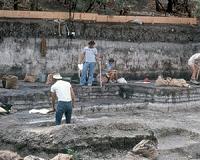 |
Tucson AZ (SPX) Oct 04, 2010 Anthropology professor Vance T. Holliday and others take issue with claims that a comet strike led to the demise of Paleoindian megafauna hunters during the Pleistocene. The notion of an object such as a comet or asteroid striking the Earth and wiping out entire species is compelling, and sometimes there's good evidence for it. Most scientists now agree that a very large object from space crashed into what is now the Yucatan Peninsula in Mexico 65 million years ago, altering climate patterns sufficiently to end the age of the dinosaurs. The theory was backed up by supporting evidence, and while not everyone in the scientific community was on board at first, it's now generally accepted. For about three years, a similar controversy has been brewing about the end of the Pleistocene, when ice sheets covered large parts of the planet and animal behemoths foraged the landscape. Prehistoric hunters developed sophisticated strategies and tool kits for bringing down mammoths and other megafauna. Did a comet striking one of those ice fields in North America nearly 13,000 years ago sufficiently alter climate enough to wipe out these animals and collapse the cultures that hunted them? A new study published in Current Anthropology argues that whether or not such an extraterrestrial event occurred, nothing in the archaeological record indicates that the Clovis hunters suddenly disappeared along with the animals. Vance T. Holliday, a professor in the University of Arizona School of Anthropology and the department of geosciences, and David J. Meltzer, an archaeologist at Southern Methodist University, studied evidence from a number of archaeological sites and concluded that it was more likely that hunting populations shifted their subsistence patterns to hunting other animals. The controversy began several years ago when scientists cited evidence of an extraterrestrial impact 12,900 years ago somewhere around the Great Lakes caused the Younger Dryas climate changes, the extinction of several large mammal species and the collapse of the Paleoindians whose large, fluted spear points - first found near Clovis, N.M. - were likely designed for hunting very big game animals. Supporters of the comet theory point out that few Clovis sites continued to be occupied after their inhabitants stopped making large projectile points. Those few old Clovis sites that are reoccupied by post-Clovis people also show a significant passage of time - as much as five centuries - between them. Holliday and Meltzer, bolstered by radiocarbon dates from more than 40 sites, counter that most prehistoric sites are kill sites where game was dispatched and butchered, and not likely to be continuously occupied. Gaps across time and the disappearance of Clovis points, they said, were more likely the result of shifting settlement patterns brought about by the nature of a nomadic existence. "Whether or not the proposed extraterrestrial impact occurred is a matter for empirical testing in the geological record," Holliday writes. "Insofar as concerns the archaeological record, an extraterrestrial impact is an unnecessary solution for an archaeological problem that does not exist."
Share This Article With Planet Earth
Related Links University of Arizona School of Anthropology Asteroid and Comet Impact Danger To Earth - News and Science
 No Evidence For Clovis Comet Catastrophe
No Evidence For Clovis Comet CatastropheWashington DC (SPX) Sep 30, 2010 New research challenges the controversial theory that an ancient comet impact devastated the Clovis people, one of the earliest known cultures to inhabit North America. Writing in the October issue of Current Anthropology, archaeologists Vance Holliday (University of Arizona) and David Meltzer (Southern Methodist University) argue that there is nothing in the archaeological record to sugge ... read more |
|
| The content herein, unless otherwise known to be public domain, are Copyright 1995-2010 - SpaceDaily. AFP and UPI Wire Stories are copyright Agence France-Presse and United Press International. ESA Portal Reports are copyright European Space Agency. All NASA sourced material is public domain. Additional copyrights may apply in whole or part to other bona fide parties. Advertising does not imply endorsement,agreement or approval of any opinions, statements or information provided by SpaceDaily on any Web page published or hosted by SpaceDaily. Privacy Statement |